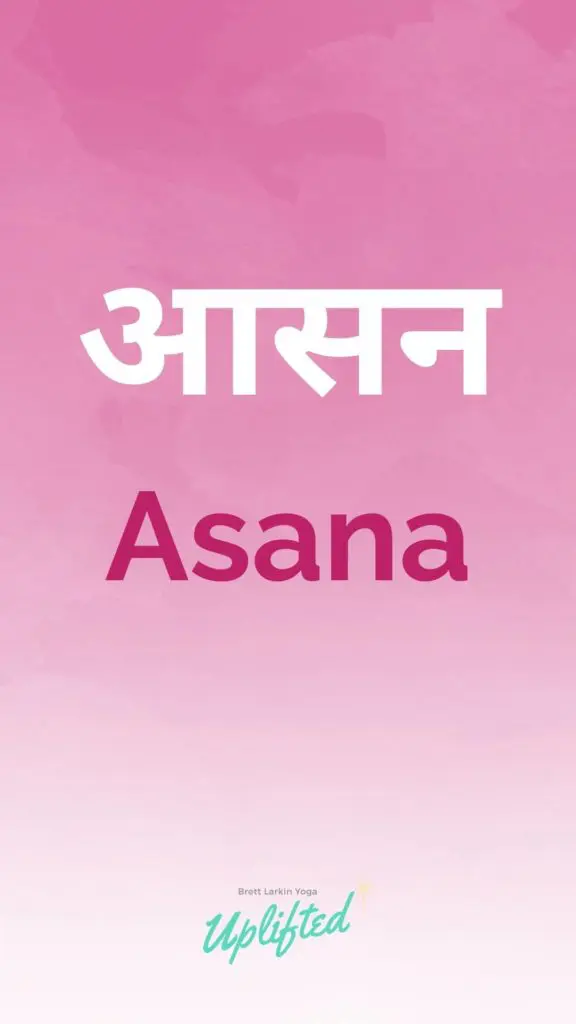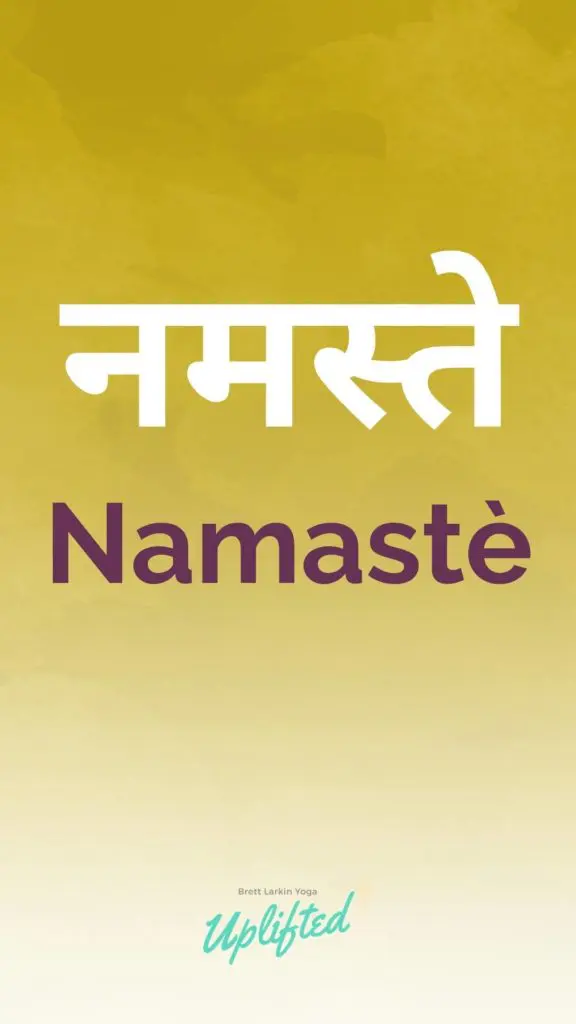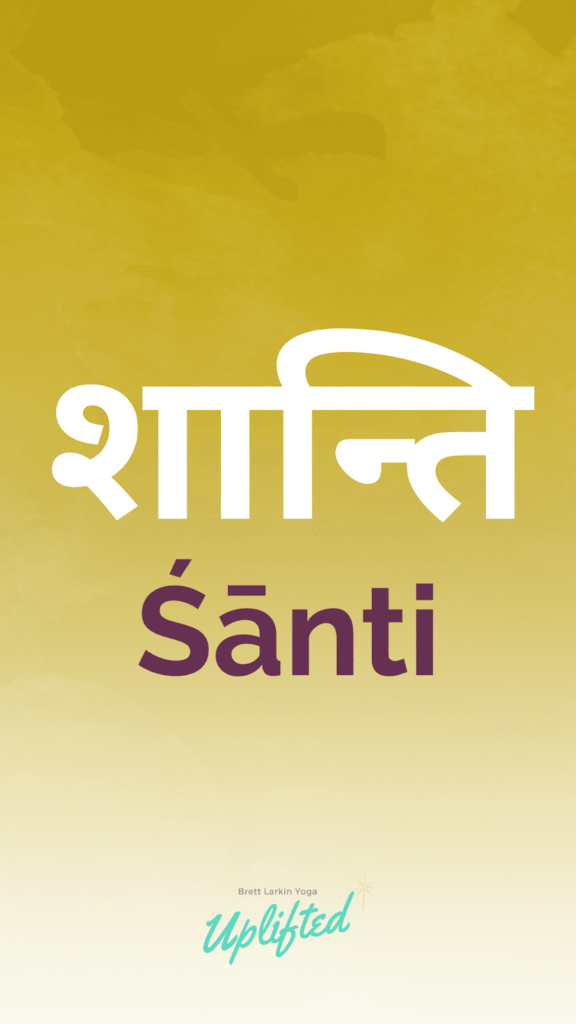While practicing yoga or when attending a yoga class, do the names of the asanas or the commonly used terms sound unusual to you? You’re definitely not alone.
Most yogis have gone through a stage where they struggled with understanding, memorizing, and pronouncing the Sanskrit words that define yoga.
You might wonder why you even have to bother learning a strange language just to do a “few stretches” when you can easily get by with the translated terminologies. True, saying “Cobra Pose” is far less complicated than attempting to pronounce “Bhujangasana“, but by avoiding Sanskrit, you’re depriving yourself of the true essence of yoga.
In this article, we’ll take a closer look at the indispensable role Sanskrit plays in yoga practice. We will also be covering the fundamental Sanskrit names and words every yogi must know.
Where Does the Sanskrit Language Come From?

Let’s first take a brief look at the origin of Sanskrit or ‘Samskrt’ (संस्कृत), which is a classical language like Greek, Latin, and Persian.
Did you know that Sanskrit is one of the oldest languages in the world with substantial documentation? Its roots can be traced back to 1700-1200 BCE. Sanskrit is the ancient language of Hinduism and has been the sacred language of Buddhism and Jainism.
Origin
We can trace Sanskrit’s linguistic history to the Proto-Indo-European languages, i.e., the people who spoke Indo-Iranian or Indo-Aryan languages. It’s also connected to the Indo-European language family; a group of hundreds of dialects and languages, native to southern and western Eurasia.
Literature
Sanskrit literature was either sung or spoken in the earlier times. For centuries the hymns, legends, incantations, the philosophical guidance for the priests, the predictions by seers, etc. were preserved and transferred orally from one generation to another.
The Devanagari script used to write the Sanskrit alphabet originated around the 7th century BCE. This script is also used to write other languages like Prakrit, Hindi, Nepali, and Marathi. Only those belonging to royalty and the priests were allowed access to learn and use Sanskrit, the rest of the society spoke Prakrit, the vernacular version of Sanskrit.
Here’s a list of some of the oldest Sanskrit classics archived in history:
- Rig Veda: The earliest forms of documentation of Sanskrit is in the Rig Veda—compiled around 1500-500 BCE—one of the four ancient Hindu scriptures.
- Bhagavat Purana: Another popular example of ancient Sanskirt literature is the Bhagavata Purana, which literally translates to “Ancient Stories of God.” It’s one of the 18 great texts in Hinduism. Bhagavata Purana promotes the devotion towards Lord Krishna, who is known to be an avatar (incarnation) of Lord Vishnu, the protector of the universe.
- Bhagavat Gita: The song of the lord/God; the ancient comprehensive guide to yoga embedded in Mahabharata comprising the teachings of Lord Krishna to Arjuna about karma yoga (the path of selfless action), bhakti yoga (the spiritual pathway of devotion), and samkhya yoga (the path of identifying the principles of existence). According to Mahabharata, the entire Bhagavad Gita was recited on the battlefield of Kurukshetra (Jyotisar, Haryana), more than 3500 years ago.
- Ashtadhyayi: Around 500 BCE, the Sanskrit scholar Panini put together Ashtadhyayi; a treatise for standardizing the grammar of Vedic Sanskrit. This included 3,959 rules of morphology, syntax, and semantics; which included about 1700 basic elements like alphabets, vowels, consonants, nouns, and verbs. Through Ashtadhyayi, Panini paved the way for classical Sanskrit.
- Yoga Sutras: Compiled by sage Patanjali between 500BCE and AD400, the yoga sutras are a collection of Sanskrit aphorisms regarding the theory and practice of yoga. These sutras and the Upanishads are still prominent today and have been translated into Arabic, Persian, and numerous West-Germanic languages.
Sanskrit was the predominant language of the Indian subcontinent until its decline around the 13th century. Though Hindi was adopted as the official language of India in 1965, Sanskrit is still in use today in the Hindu prayers and rituals, Buddhist chants, and Jain literature. It is estimated that at least 46% of the world population speak some version of Indo-European languages.
How Are Sanskrit and Yoga Connected?

To start off with, the origin of yoga can be traced back to 5000 years, and its first mention is in Rig Veda, which is documented in Sanskrit. As I mentioned earlier, many ancient yoga texts like Patanjali’s Yoga Sutras were originally written in Sanskrit. Direct connection right there! But let’s go on…
Aside from the clear connection with the ancient yoga texts, a major factor that deems this language irreplaceable in yoga and other sacred rituals is its divine sound quality. Sanskrit not only provides us with a spiritually precise vocabulary but also a unique fluidity and harmony of vibrations.
Trying to practice yoga, let alone master it without Sanskrit is like learning to swim without water. To embrace yoga in its entirety, yogis need to understand the deep, rich, philosophy behind it. And Sanskrit is the language through which this philosophy pulsates, lives, and thrives.
Though the importance of learning Sanskrit alongside yoga is a never-ending debate in the West, seasoned practitioners unanimously agree that understanding Sanskrit will enable yogis to embrace the mystical and transcendent nature of yoga completely. Transferred orally for thousands of years, every Sanskrit word is believed to have a consciousness, a trace of magic; understanding and pronouncing these words will awaken enlightened consciousness within ourselves.
To help you out with this learning process, I’ve compiled this helpful Sanskrit dictionary for you with yoga-related Sanskrit terms, beautiful Sanskrit words, and other commonly used Sanskrit words. For each word, I’ve provided pronunciation guides, original meaning, English translation, and interesting facts.
Now you will never have to rush to Google each time you come across a new Sanskrit word. You will have it all here!
Ready to jump into this journey of learning Sanskrit? Let’s get into it.
Top 5 Sanskrit Words Every Yogi Should Know
Let’s start slow. Learning a new language takes time and effort, especially if it is a language as ancient and complicated as Sanskrit. Some Sanskrit words are trickier to pronounce than others. It is always recommended to stick to the basics first and then work your way up. Here are 5 Sanskrit words that will help you stay afloat as you dive into the vast ocean of yoga vocabulary.
1. Asana (आसन ) – Seat or Pose
Pronounced: aah-sa-nah
Asana is one of the first Sanskrit words every beginner yoga student will come across in a yoga class or tutorial. Simply put, asana means ‘seat’. But in yoga, the word asana is also interchangeable with ‘pose’.
Asanas are part of the Hatha yoga style which predominantly involves physical movement.
Want to learn more about each yoga posture/asana? Here is Uplifted’s detailed Yoga Pose Dictionary.
2. Namaste (नमस्ते ) – Hello or I bow to you
Pronounced: na-mah-sthey
Short answer; namaste is the desi version of ‘hello’. It is how people greet each other in India, though now we’re no strangers to “hey”, “hello”, and “what’s up?”.
Literally, the Sanskrit translation of namaste means “I bow to you”. In terms of yoga, namaste conveys how the “divine light within me sees and bows down to the divine light within you”. It is a simple yet profound way of telling someone that you see, acknowledge, and respect them. Namaste means the same in Hindi too.
3. Om (ॐ) – The original sound
Pronounced: ohhmmm
You may have come across this symbol used as a logo or on the name boards, walls, and prayer rooms of Indian homes and restaurants. Om is not just a sound yogis make when they mediate; this Sanskrit word/symbol has a profound meaning attached to it.
According to the Brahminical Hindu tradition in India, om is considered the original sound—the one from which all the other sounds in the universe came into being.
When a yogi chants “ohhmmm”, they are tapping into the vibrations of the universe, the rhythm at which our world breaths.
4. Shanti (शांति) – Peace
Pronounced: shaan-thi
Shanti is the Sanskrit word that symbolizes peace. According to Hindu and Buddhist traditions, shanti is chanted three times to invoke peace in the body, mind, and speech.
Another interpretation is that chanting it thrice represents peace on the three levels of consciousness—when we are awake, asleep, and dreaming. Shanti stands for ‘peace’ in other languages like Hindi, Nepali, Telugu, Kannada, Malayalam, etc.
Learn how to practice the serene yet powerful om shanti shanti shanti mantra to fully tap into your meditation sessions and achieve uninterrupted peace.
5. Yoga (योग) – The divine union of the mind, body, and spirit
Pronounced: Yo-gaa
The word ‘yoga’ comes from the Sanskrit word ‘Yuj’ which means ‘to yoke’, ‘to join’, or ‘to unite’. Just like its name, the practice of yoga represents the divine union of the mind, body, and spirit.
The word yoga also celebrates the oneness of the individual consciousness with the divine consciousness of the universe, symbolizing the beautiful harmony between man, nature, god, and ultimately, the truth of the universe.
You Might Also Like: 10 Yoga Terms That Every Yogi Must Know
19 Beautiful Words in Sanskrit You’ll Want to Know
Here are 19 of my favorite Sanskrit words. Each of them has a profound meaning and a poetic ring to it.
1. Agni (अग्नि) – Fire
Did you know that Fire is considered a Vedic god in Hinduism? He is believed to have two faces according to scriptures—one kind and another spiteful. He is also the god of the sun and lightning.
2. Ananda (आनन्द) – Bliss
Ananda is the Sanskrit word that symbolizes bliss, which according to Indian philosophy is a vital attribute of the supreme being—Brahman—the highest state of self. This bliss is characterized by the emotion one feels when they are finally content with who they are and free from the limitations of the physical body.
3. Asha (आशा) – Hope
The term Asha was derived from the Sanskrit word ‘Asa’ which stands for hope, desire, or wish. Asha is a popular female name in India. According to Hindu mythology, Asha was the wife of a Vasu (demigod).
4. Atman (आत्मन्) – The Universal Self
Atman is the basic concept upon which all Hindu scriptures, epics, and legends revolve. It represents our soul; our essential being; the universal self which either transmigrates into a new life (reincarnation) or is released after death.
5. Balika (बालिका) – Girl
Balika is the Sanskrit term for ‘girl’ or ‘young woman’. Hindi too uses the same word to refer to young women. According to legends, Balika is also the name of a serpent-demon.
6. Balak (बालक) – Boy
Balak is the Sanskrit equivalent of a ‘boy’. This word is used to refer to a young boy or a male pupil.
7. Bhakti (भक्ति) – Devotion
When literally translated to English, bhakti means ‘devotion’. It can also mean love. This is a state of mind where a devotee surrenders themselves completely to the divine being, without any questions or hesitation.
8. Guru (गुरु) – Teacher
This is a term many of you will be already familiar with, especially if you are attending yoga classes where you have to address your yoga teacher as a ‘Guru’. Guru is Sanskrit for ‘Teacher’. It also means guide, mentor, expert, or master. According to Indian traditions, a teacher is the equivalent of God.
9. Jnana (ज्ञान) – Spiritual Knowledge
Jnana is the ultimate goal every yogi is in pursuit of. It refers to the spiritual knowledge one gains through self-enlightenment, the knowledge that one is eternally bound to the divine, rather than the knowledge about the world (Vijnana or general knowledge) which cannot fulfill the soul.
9. Karma (कर्म) – The Cause And Effect Of Our Actions
Here’s another word we all use a lot. While we often tend to talk about Karma being a b***h, the true meaning of karma is ‘the cause and effect of our actions’. Meaning, we are solely responsible for our karma.
10. Maya (माया) – An Illusion
All of us will know at least one ‘Maya’ from our friend circle. It is a popular name not just in India, but across the world. Do you know the true meaning of this word? According to Hindu philosophy, Maya refers to God’s power to make humans believe in what is not real; an ‘illusion’.
11. Moksha (मोक्ष) – The Final Enlightenment
Hindu mythology believes that our body is just a temple for our soul, which is the true essence of our innermost self. Once our bodies die, our souls either move on to a new life or are released to be one with God. This ‘release’ is called Moksha.
This is a concept that is also followed in Buddhism, Jainism, and Sikhism. Moksha is the ultimate freeing of the soul; the final enlightenment.
12. Prajna (प्रज्ञा) – Wisdom
The English meaning of Prajna is ‘wisdom’. But not just any wisdom—it is the highest, purest, most powerful form of knowledge, understanding, and intelligence. This level of enlightenment is above the knowledge gained from education, reasoning, and experience.
13. Prakriti (प्रकृति) – THe Primal Nature of a Being
The word Prakriti refers to the primal nature of a being or a thing. It symbolizes the original state at which a person, animal, or thing came into existence. This term has been derived from the Sanskrit word ‘pra’, meaning ‘beginning’ and ‘kriti’, meaning ‘creation’.
14. Prana (प्राण) – Life Force
Prana is the life force that flows through every being. It has been derived from the Sanskrit meaning of ‘breath’, which pervades reality on all levels, including non-living objects.
The concept of prana or the ‘vital life force energy’ exists in multiple cultures across the world. It is called Ki in Japan, Qi or Chi in China, and Mana in Polynesia. It is known as the Holy Trinity in Christianity.
15. Pratyahara (प्रत्याहार) – Withdrawal of Senses
The literal English meaning of pratyahara is ‘withdrawal of senses’. Yoga trains people to let go of their materialistic wants and binding emotions, helping them reach a stage of complete harmony, where they have complete control over their senses.
It has been derived from the Sanskrit words, prati, meaning ‘against’ and ahara, meaning ‘food’ (for your body or soul). It is a state of mind when one has complete power over reality and self, free from all kinds of external influences.
16. Rachnatmak (रचनात्मक) – Great Creativity
Next time someone displays great creativity, you can call them, “Rachnatmak”. When translated to English, rachnatmak would mean the ability to imagine, innovate, and create original ideas and unique results, which are pleasing to the eye, soul, or both.
17. Satya (सत्य) – Truthfulness
Satya means truthfulness in English. Though truthfulness is a virtue across the world, it is one of the major principles of Indian religions, referring to the path of truthfulness or purity one should tread on—be it their thoughts, intentions, speech, or actions. In Sanskrit, the word sat stands for ‘true essence, ‘true nature’, ‘fact’, ‘reality’, or ‘that which exists’.
18. Sukha (सुख) – Happiness
Sukha means happiness, comfort, joy, or pleasure in Sanskrit. According to the ancient scriptures, sukha connoted a state of mind where one experiences a pure, authentic state of happiness as opposed to the transient pleasures of the world around them.
19. Sundar (सुन्दर) – Beautiful or Attractive
Sundar is a Sanskrit adjective used to describe beauty. It describes a person or thing as being attractive, good, nice, pretty, handsome, or beautiful. It also happens to be a popular male Indian name among speakers of Indo-Aryan languages.
10 English Words With Sanskrit Origin

Being one of the ancient Indo-Aryan languages in the world, many linguists see Sanskrit as the “Mother of most Languages” though this view is varied.
Its geographical reach extends to neighboring countries like China, Korea, Japan, Tibet, as well as countries in South Asia, South East Asia, Europe, and America. Some of these languages include Hindi, Urdu, Kannada, Telugu, Malayalam, and Malay. The Sanskrit language is even related to Greek, Latin, and English with stark similarities in grammar, script, and phonetics.
Here are a few interesting examples of English words with Sanskrit roots, derived from Hindi, Greek, Latin, and Persian.
- Avatar, Sanskrit Origin: Avatara (Incarnation of the supreme being on Earth) (H)
- Calendar, Sanskrit Origin: Kaal (Time) (L)
- Cow, Sanskrit Origin: Gau (Cattle, ox) (G)
- Dental, Sanskrit Origin: Danta (Teeth) (L)
- Gene, Sanskrit Origin: Jan (Generation) (G)
- Jungle, Sanskrit Origin: Jangala (Uncultivated land) (H)
- Lilac, Sanskrit Origin: Nila (Dark blue) (P)
- Serpent, Sanskrit Origin: Sarpa (Snake) (L)
- Smile, Sanskrit Origin: Smi (Fully blossomed, expanded) (L)
- Voice, Sanskrit Origin: Vachas (Speech) (L)
80 Other Common Sanskrit Words Used in Yoga

Here’s a comprehensive list of the other common Sanskrit words that will help deepen and strengthen your yoga practice and meditation.
A
- Abhyasa (अभ्यास): Practice. It refers to the practice of discipline to achieve tranquility and self-enlightenment.
- Acharya/Ācārya (आचार्य): A Hindu religious teacher well-versed in scriptures and Vedas. In general, it signifies any knowledgeable person who imparts discipline.
- Adho (अधः): Downward; derived from the Sanskrit word adhas which means ‘down’ or ‘below’. (Like in the yoga pose downward dog.)
- Advaita (अद्वैत): The belief and teaching according to the Upanishads that there is only a single reality in this universe, i.e., the Atman or the Brahman.
- Ahamkara (अहंकार): The ‘individuality’ or the ‘ego’; the identification or attachment with one’s self or ego. Ahamkara is derived from the Sanskrit word aham, meaning ‘I’ and kāra, meaning ‘to do’ or ‘any created thing’. According to the teachings of Vedas, ahamkara is something you need to transcend to attain enlightenment.
- Ahimsa (अहिंसा): Non-violence; ahimsa is the primary yama of the five yamas which promotes compassion and non-harming. It is derived from the Sanskrit word hims, which means to strike, and the prefix ‘a’, which connotes the opposite of the action; just like ‘safe’ and ‘unsafe’.
- Akasha (आकाश): The ether or space, which is one of the five elements out of which the universe was composed. Akasha is also used to signify the space within ourselves; our inner peace. In Hindi, it also means ‘sky’.
- Amrita/Amrit (अमृत): Immortality; often referred to as the ambrosia or nectar from the ancient Hindu scriptures that granted immortality to anyone who consumed it. In yoga, Amrit signifies the immortal spirit that lives inside the vessel that is your body. When activated through meditation and asanas, this nectar oozes from the crown chakra, rejuvenating your spirit and transforming your body into a divine temple.
- Anga (अङ्ग): Limb; a basic segment of the yogic path, a part of the body. Anga is also the name of a historical kingdom that belonged to the Indian subcontinent between 1100-500 BCE.
- Arjuna (अर्जुन): Silver or bright, Arjuna was one of the five Pandava princes from the Hindu epic Mahabharatha. He was an excellent archer and the disciple of Lord Krishna—their relationship signifies the eternal bond between the soul and the universe.
- Ashrama (आश्रम): Hermitage or retreat; a stage of life when a man or woman renounces all their materialistic possessions and social ties to retreat into the forest to live out the rest of their days in prayer and meditation, amidst the simplicity of Mother Nature.
- Ashtanga Yoga (अष्टाङ्गयोग):Ashtanga Yoga signifies the eight-limbed union or the eightfold yoga established by Patanjali. Asht means ‘eight’ and Anga means ‘limb’. The eight limbs help you attain moksha or kaivalya (liberation). Those limbs include:
- Asmita (अस्मिता): The ‘I’ or the ‘individuality’; a concept that exists in Ashtanga yoga, similar to ahamkara.
- Avdhuta (अवधूत): Sage, monk; a person who has shed all worldly comforts and personal ties.
- Avidya (अविद्या): Ignorance; the opposite of vidya, which means knowledge. According to the ancient scriptures, ignorance is considered the root cause of all our suffering.
- Ayurveda (आयुर्वेद): Life science; the ancient Indian art and science of healing using natural resources. This siddha (perfected) line of medicine has originated from South India, predominantly, Kerala.
B
- Bandha (बन्ध): Bondage, bond, tie; the undeniable fact that every human is bound by the invisible ties of ignorance (avidya) and bhoutik (materialistic) desires. One can break free only with the divine power of jnana (knowledge).
- Bhakta (भक्त): Follower, devotee; a disciple who practices Bhakti yoga. It is also used to describe any person who believes, worships, or practices a principle/prayer in regard to the divine being.
- Bhakti Sutra (भक्तिसूत्र): Sayings, aphorisms of devotion; also known as Narada Bhakti Sutra, it is a renowned sutra (collection of sayings) within the Hindu tradition, believed to be narrated by the divine Narada Muni (Sage Narada) who used to travel across spiritual realms to deliver news across gods and demigods and impart wisdom to humans.
- Bhakti Yoga (भक्तियोग): Bhakti Yoga is the yoga of devotion that is focused on reaching out to the uttama purusha (the supreme being) with the transcendental capacity of the human mind and the enlightening power of yoga. It is one of the four main branches of yoga.
- Bhavana (भावना): Development, cultivation, imagination; It is a meditation technique exercised in yoga where the yogi visualizes a character—love, compassion, peace—turning into light or energy of the divine, thus bringing them closer to enlightenment and liberation.
- Bindu (बिंदु): Point, seed, dot; the potent point on the forehead that is believed to be where the third eye is situated. It is the point where all energies are focused.
- Bodhi (बोधि): An enlightened person; someone who has awakened to the reality and is content with it. Also, another name for Buddha.
- Brahma (ब्रह्मा): The creator; the god that has created everything in this universe according to the first tatva (principle) which describes how the world and everything in it emerged out of the divine reality.
- Brahmacharya (ब्रह्मचर्य): Celibacy, abstinence; Brahmacharya can be literally interpreted as following the ultimate reality, the Brahman, by abstaining from worldly pleasures, especially those of the flesh.
- Brahman (ब्रह्मन्): The ultimate reality; the atman or parama purusha (divine creator), who has shaped the universe and everything within it.
- Brahmana (ब्राह्मण): A Brahmin; originally an occupational class that comprised of priests, which used to be the highest-ranking distinction in the ancient Indian society. These occupations of scholars/priests, rulers/warriors, merchants, and laborers eventually transformed to the four major Hindu castes—Brahmins, Kshatriyas, Vaishyas, and Shudras respectively.
- Buddha (बुद्ध ): The one who has awakened; a person who has attained enlightenment and inner peace. Buddha also refers to Gauthama Buddha, the revered philosopher, scholar, and founder of Buddhism.
- Buddhi (बुद्धि): Conscious; awake, aware; a state of awareness where your mind attains a higher level of knowledge, wisdom, and intelligence by understanding the divine reality.
C
- Chakra (चक्र): A Chakra is a wheel or energetic center; the metaphorical wheels or centers of energy that exist in and around our subtle body. Mainstream yoga recognizes seven chakras in the human body:
- Muladhara (Root Chakra)- Location: Pelvis or perineum, Significance: Trust
- Svadhisthana (Sacral chakra)- Location: At the tailbone, Significance: Creativity, Sexuality
- Manipura (Solar Plexus chakra)- Location: On the spine, at the level of the navel, Significance: Wisdom, Power
- Anahata (Heart chakra) – Location: On the spine, at the level of the heart, Significance: Healing, Love
- Vishuddha (Throat chakra)- Location: On the spine, at the level of the throat, Significance: Communication
- Ajna (Third eye chakra)- Location: Center of the forehead, Significance: Awareness
- Sahasrara (Crown chakra)- Location: Crown of the head, Significance: Spirituality
- Cin-mudra (चिन्मुद्रा): Seal of consciousness; a common mudra (hand gesture) used during meditation by bringing the index finger towards the thumb, keeping the remaining fingers open, and resting the palms on the knees.
- Chit/Citt (चित् ): Divine consciousness; the awareness of the atman or brahman, awakening to the ultimate reality.
- Chitta/Citta (चित्त): The mind; the human mind which is conscious before attaining Chit or Citt (divine consciousness).
D
- Darshana (दर्शन): Seeing, viewing; literally and metaphorically speaking. Darshana is the way of viewing the world. There are six worldly views according to the Hindu philosophy, out of which, Yoga Darshana comprises the sutras (sayings) of Patanjali.
- Deva (देव): God, male deity; literally translated as ‘he who is shining’. There are many devas in Indian mythology, such as Brahma, Vishnu, Shiva, Krishna, Indra, etc.
- Devi (देवी): Goddess, female deity; literally translated as ‘she who is shining’. Some of the Indian goddesses include Saraswati, Parvati, Lakshmi, and Kaali.
- Dharana (धारणा ): Focus, holding; the sixth anga (limb) of ashtanga yoga that is the practice of steadying the mind, preparing it for the seventh limb, which is dhyana (meditation).
- Dharma (धर्म): Duty, purpose, virtue; Dharma is the opposite of Karma. It signifies the sense of righteousness or the spiritual pathways one is supposed to follow to uphold truth and attain yogic healing.
- Dhyana (ध्याना): Meditation; the seventh anga (limb) of ashtanga yoga that calms that unites the mind, body, and soul with tranquility, inner peace, and self-awareness.
- Diksha (दीक्षा): Initiation, commencement, inception; an act of inducing a disciple into yoga practice, predominantly kriya yoga.
- Drishti (दृष्टि): Vision, sight; Drishti is a focused gaze at a point at the tip of the nose or between the eyebrows to steady the mind during meditation.
- Dukha (दुख): Sorrow, sadness, discomfort; the suffering endured by humans throughout their lives until they get moksha (divine relief) from the shackles of the body. The darkness of Dukha can be fought only with the light of jnana (knowledge) and pratyahara (sensory restraint).
E
- Eka (एक): One; often used in yoga to specify the movement of a single limb. For example, Eka Pada Rajakapotasana means one-leg pigeon pose.
G
- Gayatri mantra (गायत्रीमंत्र): A universal prayer and a Vedi mantra chanted in the morning, particularly during sunrise. Learn more about this mantra here.
- Guna (गुण): Quality; guna refers to the good qualities and virtues of a human being.
H
- Hatha ( हठ): The word Hatha is made of ‘ha’ which means the Sun and ‘tha’, which means the moon. When practicing Hatha yoga, both the Sun and Moon energies within you get balanced, thus cleansing and energizing your body.
- Hatha Yoga (हठयोग): Forceful yoga; an umbrella term used for any type of yoga that involves physical movement, postures, and breath control. Learn more about Hatha Yoga.
I
- Ida nadi (इडानाडि): Moon channel; Ida Nadi symbolizes the lunar energy channel in your body that is on the left (ida) side of Sushumna Nadi; the central energy channel linked with your parasympathetic nervous system.
- Ishvara (ईश्वर): Lord, God; refers either to Brahma, the creator of the universe, or a transcendental being, according to Patanjali.
- ISHTA Yoga (इष्टयोग): A blended yoga style of the ancient and contemporary schools. ISHTA is the acronym for the ‘Integrated Science of Hatha, Tantra, and Ayurveda’.
J
- Jnana Yoga (ज्ञानयोग): Yoga of knowledge; one of the four main branches of yoga that helps you tread a path of intellect and wisdom through the power of meditation.
- Japa (जप): Chanting, muttering; the recitation of a prayer.
- Jivatman/Jiva-atman (जीवात्मन्): The self; the individual consciousness, which is the opposite of paramatman (the ultimate self).
K
- Karma Yoga (कर्मयोग): Yoga of action; one of the four main branches of yoga that focuses on doing good for others through service and selfless actions.
- Kriya (क्रिया): Action; refers to a completed effort or physical action.
- Kriya Yoga (क्रियायोग): Kriya Yoga is one of the simpler yoga styles involving pranayama, meditation, and simple living.
- Kundalini Shakti (कुण्डलिनी शक्ति): Coiled power; Kundalini shakti refers to the serpent energy or spirit that lays dormant in the Muladhara chakra (root chakra).
L
- Laya Yoga (लययोग): An advanced form of Tantric yoga that involves awakening the kundalini shakti to dissolve all the chakras into one.
- Linga (लिङ्ग): Sign, symbol; the phallus symbol believed to be an abstract representation of Lord Shiva.
M
- Manas (मनस् ): Mind; the lower level of consciousness and intelligence that is aware of vijnana (worldly knowledge) as opposed to jnana (spiritual wisdom).
- Mantra (मंत्र): Chant; the repeated utterance of a prayer or a sacred word like om. A mantra helps you focus during mediation and connect on a deeper level with the ultimate being.
- Marman (मर्मन्): Spot; a significant bindu (spot) in the body where energy is either accumulated or blocked.
- Mudra (मुद्रा): Hand gesture, seal; the various positions in which you arrange your hands and fingers during yoga practice or meditation.
N
- Nadi (नाडि): Tube, channel; the energy channels which flow through your body, namely, Ida Nadi (left channel), Sushumna Nadi (central channel), and Pingala Nadi (right channel).
- Niyama (नियम): Observances; the second limb that belongs to Patanjali’s eightfold path for enlightenment, which dictates the rules for living right. The five niyamas are saucha (purity), santosha (contentment), tapas (self-discipline), Svadhyaya (self-study), and ishvara pranidhana (surrendering to the divine).
O
- Ojas (ओजस् ): Energy, vitality; the raw, pure energy produced by the practice of discipline, especially brahmacharya (celibacy).
P
- Paramatman (परमात्मन्): The ultimate self; the supreme, transcendental self that represents the ultimate reality. Paramatman is revealed to you through the practice of yoga.
- Pingala Nadi (पिङ्गलानाडि): The solar energy channel in your body that is on the right side of Sushumna Nadi; the central energy channel which flows up your spinal column, through all the seven chakras.
- Pranayama (प्राणायाम): Breath control, breath expansion; pranayama is one of the basic and vital breathing exercises which acts as a preparatory practice for other asanas. It can be interpreted in two ways: controlling your breath or letting your breath control you.
R
- Raja yoga (राजयोग): Royal yoga; one of the four main branches of yoga, Raja yoga helps you develop all the qualities of a king by combining Bhakti yoga, Jnana yoga, and Karma yoga.
S
- Samadhi (समाधि): Together, complete; samadhi is the final step in yoga, as per Patanjali’s Yoga sutras. It can be defined as the pinnacle of inner peace and self-awareness, which allows the yogi to unite with the universal consciousness.
- Sanyasin (सन्न्यासिन्): Sage, monk; someone who has renounced all worldly comforts and desires.
- Shakti (शक्ति): Power; the feminine aspect of the ultimate reality.
- Shiva (शिव): Benign, kind, divine; the Hindu god of destruction and restoration.
- Sushumna Nadi (सुषुम्नानाडि): Main central channel; the channel of energy that runs through the center of your spine. The purpose of Hatha yoga is to redirect the Ha/Pingala/Solar energy and Tha/Ida/Lunar energy to the Sushumna Nadi so you attain the deepest form of mediation and bliss.
- Swapna (स्वप्न): Dream; Puranas (ancient history) refer to swapna as a dream, which could be true-sensed, rich-sensed, or senseless.
T
- Tantra (तन्त्र): Loom, weave; tantra is a metaphorical term used to describe how various teachings and traditions are weaved in together as “threads” into a discipline or text.
- Tapas (तपस्): Warmth, Penance; Tapas could either mean ‘heat’ or the long periods of meditation (without food or sleep) sages used to observe to appease the gods.
U
- Upanishad (उपनिषद्): The centuries-old sacred Hindu scriptures. when translated literally, Upanishad means ‘sitting down in proximity’. This term was coined because the disciples used to sit next to the teacher to receive knowledge.
If you are still in the early stages of getting a hold of Sanskrit, recording a yoga journal may make it easier for you to keep track of the words you are learning each day.
Learning Sanskrit not only opens the gates of a sublime culture steeped in rich wisdom, but will also help you experience yoga at levels you could never have imagined before.
Happy learning!
Next Steps
- If you’re interested in practical kriya yoga as a way to improve your daily life and relationships, check out my Yoga for Self Mastery course.
- Order my Yoga Life book for a practical guide to creating balance in your life through yoga.
- Check out my YouTube channel and find some yoga classes that you can try out for yourself!
Experience 3 Training Videos from Inside My 200-Hour Online YTT

YOU MIGHT ALSO LIKE
- What is Kriya Yoga? The Philosophy and Practice
- Uddiyana Bandha: Tapping Into Your Deep Core
- 4 Reasons Hasta Bandha Is Essential To Your Yoga Practice
- Vitarka Mudra: What It Is and How Do You Use It?
- Shakti Mudra: What It Is and How Do You Do It?
- Garuda Mudra: What It Is and How Do You Use It?
- Kali Mudra: What It Is and How Do You Do It?
- Shunya Mudra: What It Is and How Do You Do It?
- Varuna Mudra: What It Is and How Do You Use It?
- Vayu Mudra: What It Is and How Do You Use It?
- Samana Vayu: The Energy of Balance & How to Access It
- Apana Vayu: The Energy of Release & Surrender
- Udana Vayu: The Ascending Wind
- Prana Vayu: The Breath of Vitality
- Vyana Vayu: The Energetic Secret to Flow
Learn how to do 11 of the most popular yoga poses correctly. Free video + PDF download.


















